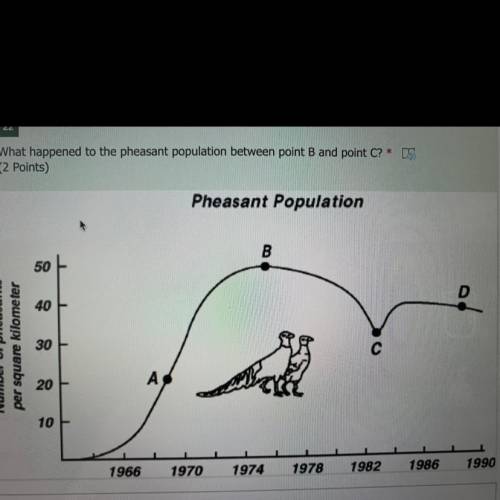
Biology, 09.03.2021 09:30 shreyasvrangan
1)What happened to the pheasant population between point B and point C? 2)From the data - What was the approximate population density(number) of pheasants at points A, B and D?


Answers: 2


Another question on Biology

Biology, 22.06.2019 00:30
Each pair of clay balls represents two planetesimals. if each planetesimal is composed of the same material and is separated he the same distance, which pair experiences the frayed gravitational attraction?
Answers: 1


Biology, 22.06.2019 08:00
Drag each label to the correct location in the equation. not all tiles will be used. the density of mercury is 13.6 grams per cubic centimeter. complete the steps for converting 13.6 g/cm3 to kg/m3. (1 kg = 1,000 g, 1 m3 = 106 cm3)
Answers: 3

Biology, 22.06.2019 09:10
Refer to this portion of a dichotomous key for fish identification to answer the question. 1. (a) has a single dorsal fin ® 5 (b) has a double dorsal fin ® 2 2. (a) one fin is spiny, the other is smooth ® 3 (b) one fin is not spiny or smooth ® 4 5. (a) has small fin on back near tail ® 6 (b) has no fin on back near tail ® 7 6. (a) has barbs near the mouth ® catfish (b) does not have barbs near the mouth ® 10 7. (a) tail is asymmetrical ® 8 (b) tail is symmetrical ® 9 10. (a) scales are small ® trout (b) scales are large ® whitefish what is the next step to complete to identify a fish that has a single dorsal fin, no fin on the back near the tail, and no barbs near the mouth? step 2 step 5 step 7 step 10
Answers: 2
You know the right answer?
1)What happened to the pheasant population between point B and point C?
2)From the data - What was...
Questions

English, 22.03.2021 17:00

English, 22.03.2021 17:00


English, 22.03.2021 17:00



Mathematics, 22.03.2021 17:00




Advanced Placement (AP), 22.03.2021 17:00

History, 22.03.2021 17:00


Mathematics, 22.03.2021 17:00

Mathematics, 22.03.2021 17:00



Mathematics, 22.03.2021 17:00


English, 22.03.2021 17:00



